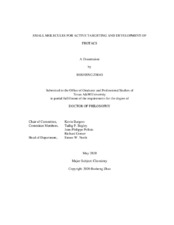| dc.description.abstract | Targeted therapy for cancer is a hot topic in recent years. Small molecule pharmaceuticals have advantages relative to antibodies with respect to cell penetration and affordability. This dissertation focuses on the application of small molecules targeting cancer. The binding of a small molecule ligand (IY-IY) to the tropomyosin receptor kinase C (TrkC), which is overexpressed on cancer cells, was validated by photoaffinity labeling (PAL) and used to deliver a kinase inhibitor (KI) into cancer cells. Further, IY-IY and two CDK4/6 inhibitors were modified to proteolysis targeting chimeras (PROTACs) which were capable of inducing degradation of their targets, providing an alternative approach of regulating protein functions.
In the first study, a PAL cassette was designed to contain an alkyne, a trifluoromethyl phenyl diazirine, and a free piperidine-NH for facile conjugation to protein binding ligands. This PAL cassette was synthesized via a relatively direct route involving routine steps. In the proof-of-concept study, a sulfonamide ligand for carbonic anhydrase IX (CAIX) and IY-IY for TrkC were conjugated to the cassette. Photoaffinity labeling experiments were performed using purified extracellular domains of both these protein-receptors, and using cells that express these receptors, labeling of the protein was observed in all experiments.
In the second study, IY-IY was used to deliver the promiscuous KI dasatinib into breast cancer cells. Conjugates with non-cleavable and cleavable linkers were compared in cellular assays and shown to have more impact on the cell viabilities of TrkC⁺ breast cancer cells over TrkC⁻ epithelial cells. The IY-IY fragment was also used to recruit the E3 ligase cereblon, giving a potent PROTAC for TrkC degradation in metastatic breast cancer cells.
In the third study, PROTACs based on two selective, FDA-approved CDK4/6 inhibitors were formed. One of them, based on palbociclib, potently initiates degradation of these CDK proteins, suppresses the downstream phosphorylation of retinoblastoma protein (Rb) and leads to cell cycle arrest. These PROTACs are active at nanomolar concentrations and appear to act catalytically in the cells. | en |


